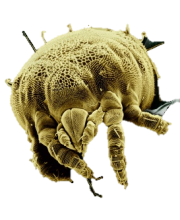
General Information
Scabies is an infestation of the skin by the human itch mite (Sarcoptes scabiei var. hominis). The tiny mite burrows into the upper layer of the skin where it lives and lays its eggs. The most common symptoms are intense itching and a pimple-like skin rash. The mite is usually spread by direct, prolonged, skin-to-skin contact with a person who has scabies. They can spread rapidly under crowded conditions where close body and skin contact is frequent. Institutions such as nursing homes, extended-care facilities, and prisons are often sites of outbreaks. Childcare facilities are also are common sites of infestations.
What is crusted (Norwegian) scabies?
It is a severe form of scabies that can occur in some persons who are immunocompromised (have a weak immune system), elderly, disabled, or debilitated. Persons with crusted scabies have thick crusts of skin that contain large numbers of mites and eggs. Persons with crusted are very contagious to other persons and can spread the infestation easily both by direct skin-to-skin contact and by contamination of items such as their clothing, bedding, and furniture. Infected persons may not show the usual signs and symptoms such as the characteristic rash or itching (pruritus). Any one infected should receive quick and aggressive medical treatment for their infestation to prevent outbreaks.
How soon after infestation do symptoms begin?
If a person has never had them before, symptoms may take as long as 4-6 weeks to begin. But patients can still spread them during this time. But if a person has had them before, symptoms usually appear (1-4 days) after exposure.
What are the signs and symptoms of infestation?
The most common signs and symptoms are intense itching (pruritus), especially at night, and a pimple-like (papular) itchy rash. The itching and rash each may affect much of the body or be limited to common sites such as the wrist, elbow, armpit, webbing between the fingers, nipple, penis, waist, beltline, and buttocks. The rash also can include tiny blisters (vesicles) and scales. Scratching the rash can cause skin sores; sometimes these sores become infected by bacteria. Tiny burrows are sometimes seen on the skin; these are caused by the female mites tunneling just beneath the surface of the skin. They are found most often in the webbing between the fingers, in the skin folds on the wrist, elbow, or knee, and on the penis, breast, or shoulder blades. The head, face, neck, palms, and soles often are involved in infants and very young children, but usually not with adults and older children. Persons with crusted scabies may not show the usual signs and symptoms such as the characteristic rash or itching (pruritus).
How are they transmitted?
They are usually spread by direct, prolonged, skin-to-skin contact with a person who has them (a quick handshake or hug usually will not spread them). They are spread easily to sexual partners and household members. It is sometimes spread indirectly by sharing articles such as clothing, towels, or bedding used by an infected person; however, such indirect spread can occur much more easily when the infested person has crusted scabies.
How is infestation diagnosed?
Diagnosis of a infestation usually is made based on the customary appearance and distribution of the rash and the presence of burrows. Whenever possible, the diagnosis should be confirmed by identifying the mite, mite eggs, or mite fecal matter.
How long can mites live?
On a person, mites can live for as long as 1-2 months. Off a person, mites usually do not survive more than 48-72 hours. Mites will die if exposed to a temperature of 50°C (122°F) for 10 minutes.
Can it be treated?
Yes. Products used to treat the mites are called scabicides because they kill the mites; some also kill eggs. Scabicides to treat human scabies are available only with a prescription. Treatment also is recommended for household members and sexual contacts, particularly those who have had prolonged skin-to-skin contact with the infested person.
How can I remove mites from my house or carpet?
Mites do not survive more than 2-3 days away from human skin. Items such as bedding, clothing, and towels used by a person with scabies can be decontaminated by machine-washing in hot water and drying using the hot cycle or by dry-cleaning. Items that cannot be washed or dry-cleaned can be decontaminated by removing from any body contact for at least 72 hours.
Because persons with crusted scabies are considered very infectious, careful vacuuming of furniture and carpets in rooms used by these persons is recommended. Fumigation of living areas is unnecessary.
How can I remove mites from my clothes?
They do not survive more than 2-3 days away from human skin. Items such as bedding, clothing, and towels used by a person with scabies can be decontaminated by machine-washing in hot water and drying using the hot cycle or by dry-cleaning for items that cannot be washed or dried.

